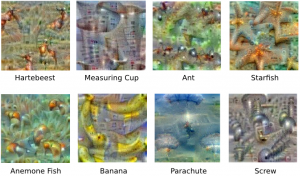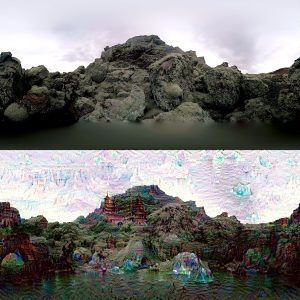Pricilla Gomes
July 12, 2023

Executive Summary
The world of the internet is unique and endless. Coming to neural networks, have made successful progress in speech recognition and image classification. Deep Dream is a fascinating image-generation technique that emerged from the field of artificial intelligence and neural networks.
Developed by Google in 2015, Deep Dream utilizes the power of deep learning algorithms to produce visually mesmerizing and surrealistic images.
The objective of DeepDream is to uncover intricate patterns and hidden features within existing images by enhancing and exaggerating them.
At its core, DeepDream employs a convolutional neural network (CNN) to analyze and understand visual information. Initially, these networks were designed for tasks such as image classification, object recognition, and visual understanding. However, researchers soon realized that the inner workings of CNNs could be utilized in a novel way to generate captivating and unique images.
The process of creating a DeepDream image involves feeding an existing image into the neural network and allowing it to interpret and modify the input. The network progressively enhances and amplifies features that it recognizes in the image.
This is achieved by iteratively optimizing the input image to maximize the network’s response to specific patterns or features. The result is a visually striking composition that accentuates and exaggerates the network’s perception of the original content.

DeepDream images often exhibit intricate and intricate patterns that resemble a blend of various objects and shapes. These dream-like creations can range from abstract and psychedelic to fantastical and surreal. The generated imagery frequently contains repeating motifs, such as eyes, animals, or architectural elements, which reflect the neural network’s internal representations and biases learned from training on large datasets.
Beyond its aesthetic appeal, DeepDream has also proven to be a valuable tool for understanding the inner workings of neural networks.
DeepDream has sparked considerable interest among artists, researchers, and enthusiasts alike, leading to the creation of numerous online platforms and software tools that enable users to generate their own Deep Dream images.
These tools often provide users with the ability to tweak various parameters and explore different layers of the neural network, giving them a greater degree of control over the final output.
Introduction
The Deep Dream algorithm is an intriguing and creative approach that merges artificial intelligence and artistry to generate visually captivating and often surreal images. Developed by Google’s DeepMind in 2015, this algorithm utilizes deep neural networks to enhance and manipulate existing images, creating mesmerizing and dreamlike visual experiences.
At its core, the Deep Dream algorithm is based on the concept of convolutional neural networks (CNNs), which are powerful machine learning models commonly used for image recognition tasks. While CNNs are primarily designed to classify and identify objects within images, the Deep Dream algorithm flips this process on its head, transforming images to emphasize and amplify patterns that the network has learned to recognize.
The algorithm achieves this by iteratively modifying the input image to maximize the neural network’s response to specific patterns or features. By running the modified image through the network and adjusting the pixel values, the Deep Dream algorithm enhances the features that the network deems significant. This iterative process is often referred to as “dreaming,” as it can produce images that appear as surreal and hallucinatory amalgamations of the original content.

One of the remarkable aspects of the Deep Dream algorithm is its ability to produce intricate and intricate patterns, from intricate textures and vibrant colors to intricate shapes and forms. The algorithm tends to focus on specific objects or structures that the neural network has been trained to recognize, resulting in visually stunning compositions that might contain repeated motifs and hallucinogenic distortions.
Beyond its artistic appeal, the Deep Dream algorithm has also been instrumental in gaining insights into the inner workings of neural networks. By examining the features that the algorithm amplifies, researchers can better understand the network’s representations and how it interprets and processes visual information.
The applications of the Deep Dream algorithm are diverse and span various domains. Artists and creative enthusiasts have embraced the algorithm as a tool for generating unique and thought-provoking images, while researchers continue to explore its potential in fields like computer vision, pattern recognition, and even psychological studies.
In this era of AI-driven innovations, the Deep Dream algorithm stands as a testament to the fascinating interplay between machine learning and human creativity, inviting us to explore the boundaries of what we perceive as reality and encouraging us to embrace the symbiotic relationship between technology and art.
Strategies of Deep Dream
The strategy behind DeepDream involves a process known as “over-optimization,” which aims to amplify the activation patterns of neurons in the CNN. By repeatedly running an input image through the network and modifying it based on the network’s response, DeepDream gradually enhances and exaggerates certain features and structures. This iterative approach emphasizes the patterns that the network has learned to recognize, resulting in a visually striking composition.
Here is an overview of the main steps involved in the DeepDream process:
Pretrained CNN: DeepDream starts with a pre-trained CNN, such as GoogLeNet or InceptionNet, which has been trained on a large dataset for tasks like image classification. These networks consist of multiple layers, each responsible for detecting specific features at different levels of abstraction.
Selecting Layers: The user selects one or more layers within the network to apply the DeepDream algorithm. Typically, layers higher up in the network hierarchy, closer to the output, are preferred as they capture more complex and abstract features.
Choosing an Input Image: An initial image is selected as the input for the DeepDream algorithm. This could be a random noise image or an existing photograph.
Forward Pass: The selected image is passed through the network in the forward direction, activating different neurons and layers along the way. The activations are computed and stored for later use.
Objective Function: DeepDream utilizes an objective function to guide the optimization process. The objective function defines what features or patterns the algorithm should enhance. One common approach is to maximize the sum of the activations of selected neurons in the chosen layers.
Backward Pass: The objective function is differentiated with respect to the input image, and the gradients are computed. These gradients indicate the direction of change that will increase the activation of the selected neurons.
Gradient Ascent: The image is updated by making small adjustments in the direction of the computed gradients. The changes are proportional to the magnitudes of the gradients, aiming to increase the activation of the desired neurons.
Iterative Process: Steps 4 to 7 are repeated for multiple iterations, gradually modifying the input image to produce increasingly surreal and abstract visual patterns. The number of iterations and the strength of the modifications can be adjusted to achieve the desired level of transformation.
Post-Processing: After the desired number of iterations, the resulting image can undergo post-processing to enhance its visual appeal. Techniques like color adjustment, noise reduction, and sharpening can be applied to refine the output.
The strategy behind DeepDream revolves around the idea of iteratively modifying an input image to amplify and emphasize the patterns learned by a CNN. By leveraging the network’s internal representations, DeepDream provides a captivating insight into the artistic potential of artificial intelligence and pushes the boundaries of visual creativity.
Future of Deep Dream Algorithm
The future of the deep dream algorithm is promising, with potential applications in various fields ranging from art and entertainment to scientific research. This algorithm, originally developed by Google, uses neural networks to generate psychedelic and dream-like images by enhancing patterns and textures within existing images.
Let’s explore some potential advancements and applications that we can expect in the future:
Enhanced Creativity and Artistic Expression
Deep Dream has already gained popularity among artists and creative enthusiasts for its ability to generate visually captivating and surreal images. In the future, we can anticipate further advancements in this area, allowing users to create even more intricate and imaginative artwork.
Interactive Deep Dreaming
Currently, deep dream is a post-processing technique applied to static images or videos. However, future developments might enable real-time interactive deep dreaming, allowing users to dynamically modify and explore the dream-like visuals. This could lead to engaging interactive experiences and immersive virtual environments.
Deep Dream for a Personalized Content Generation
As the algorithm evolves, it could become more tailored to individual preferences. Users might have the ability to input specific parameters or styles, resulting in personalized deep dream outputs. This would enable users to create unique visuals that resonate with their personal tastes.
Deep Dream for Video Games and Virtual Reality
Deep dream could find its way into the gaming industry, where it has the potential to enhance visual effects and create mesmerizing environments. Integrating deep dream into virtual reality experiences could transport users to visually stunning and immersive dreamscapes.
Scientific Applications
Deep dream has already been utilized in scientific research, particularly in the field of neuroscience. By applying deep dream to neural network models trained on medical imaging data, researchers can gain insights into brain activity and better understand complex neurological disorders. In the future, deep dream could be further leveraged to uncover hidden patterns and aid in medical diagnoses.
Deep Dream for Data Visualization
With the ability to enhance patterns and textures, deep dream can be used for data visualization, making complex datasets more visually understandable. By applying deep dream techniques to graphs, charts, and other visual representations, researchers, analysts, and decision-makers can gain new perspectives and insights from their data.
Ethical Considerations and User Control
As deep dream technology advances, it is crucial to address ethical concerns. Developers will need to ensure user control and consent, allowing individuals to have agency over the generated content and avoid any unintended consequences. Providing transparency and empowering users to modify or filter the deep dream effects will be vital.